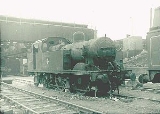
LMS Stanier 0-4-4T
Encyclopedia
The London, Midland and Scottish Railway
(LMS) Stanier 0-4-4T was a class of 10 light passenger locomotives built in 1932. Ostensibly designed under new CME William Stanier
, they were in fact the last new design of the Midland Railway
's school of engineering.
s. British Railways adding 40000 to their numbers making them 41900–9. Although the last new Midland-style design, as subsequent Stanier engines incorporated much Great Western Railway
practice, they were not the last MR-designed locomotives built with some 4Fs
appearing as late as 1940.
The class was originally built with stovepipe chimneys, apparently due to an oversight by Stanier due to the design for future LMS locomotive chimneys not being finalised. All were later fitted with Stanier chimneys.
The locomotives were fitted with vacuum control gear for working motor trains.
(Motor trains was the terminology used by the LMS although they later became popularly referred to as push-pull train
s. The suitably modified stock was marked as pull-push).
London, Midland and Scottish Railway
The London Midland and Scottish Railway was a British railway company. It was formed on 1 January 1923 under the Railways Act of 1921, which required the grouping of over 120 separate railway companies into just four...
(LMS) Stanier 0-4-4T was a class of 10 light passenger locomotives built in 1932. Ostensibly designed under new CME William Stanier
William Stanier
Sir William Arthur Stanier, FRS was Chief Mechanical Engineer of the London, Midland and Scottish Railway.- Biography :...
, they were in fact the last new design of the Midland Railway
Midland Railway
The Midland Railway was a railway company in the United Kingdom from 1844 to 1922, when it became part of the London, Midland and Scottish Railway....
's school of engineering.
Overview
The Midland Railway had a large number of 1P 0-4-4T and this was a larger version of the larger wheeled design, classified 2P. The ten built were numbered 6400–9 by the LMS and renumbered 1900–9 shortly before nationalisation, freeing the numbers for new LMS Ivatt Class 2 2-6-0LMS Ivatt Class 2 2-6-0
The London, Midland and Scottish Railway Ivatt Class 2 2-6-0 is a class of steam locomotive designed for light mixed traffic.-Design:...
s. British Railways adding 40000 to their numbers making them 41900–9. Although the last new Midland-style design, as subsequent Stanier engines incorporated much Great Western Railway
Great Western Railway
The Great Western Railway was a British railway company that linked London with the south-west and west of England and most of Wales. It was founded in 1833, received its enabling Act of Parliament in 1835 and ran its first trains in 1838...
practice, they were not the last MR-designed locomotives built with some 4Fs
LMS Fowler Class 4F
The London Midland and Scottish Railway Fowler 4F is a class of 0-6-0 steam locomotive designed for medium freight work. They represent the ultimate development of Midland Railway's six coupled tender engines.- Background :...
appearing as late as 1940.
The class was originally built with stovepipe chimneys, apparently due to an oversight by Stanier due to the design for future LMS locomotive chimneys not being finalised. All were later fitted with Stanier chimneys.
The locomotives were fitted with vacuum control gear for working motor trains.
(Motor trains was the terminology used by the LMS although they later became popularly referred to as push-pull train
Push-pull train
Push–pull is a mode of operation for locomotive-hauled trains allowing them to be driven from either end.A push–pull train has a locomotive at one end of the train, connected via some form of remote control, such as multiple-unit train control, to a vehicle equipped with a control cab at the other...
s. The suitably modified stock was marked as pull-push).
Details
| LMS 1932/3 No. | LMS 1946 No. | BR No. | Date built | Date motor gear fitted | Withdrawn |
|---|---|---|---|---|---|
| 6400 | 1900 | 41900 | 1932–12 | 1950–9 | 1962–3 |
| 6401 | 1901 | 41901 | 1932–12 | 1951–2 | 1959–11 |
| 6402 | 1902 | 41902 | 1932–12 | 1950–9 | 1959–11 |
| 6403 | 1903 | 41903 | 1932–12 | 1950–9 | 1959–11 |
| 6404 | 1904 | 41904 | 1932–12 | 1950–9 | 1959–11 |
| 6405 | 1905 | 41905 | 1932–11 | 1951–1 | 1959–11 |
| 6406 | 1906 | 41906 | 1932–12 | 1957–3 | 1959–11 |
| 6407 | 1907 | 41907 | 1932–12 | 1951–3 | 1959–11 |
| 6408 | 1908 | 41908 | 1932–12 | 1934–7 | 1959–11 |
| 6409 | 1909 | 41909 | 1933–1 | 1934–3 | 1959–11 |
External links
- http://www.railuk.co.uk/steam/getsteamclass.php?item=2P-C

